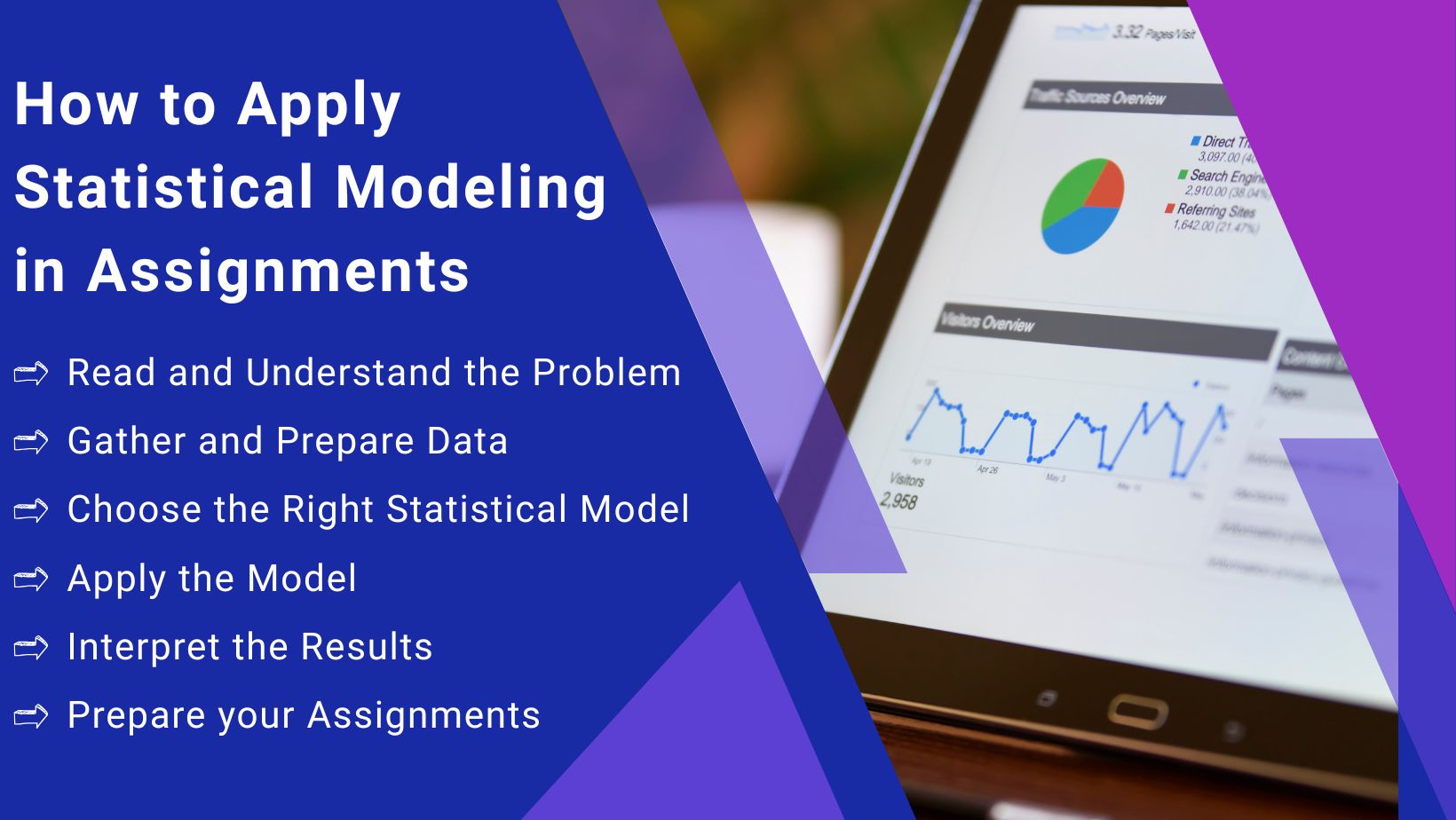Statistical modeling uses statistical techniques to analyze and interpret complex data, identify patterns, and make predictions. To apply it in assignments, you should understand the problem, collect data, choose the right statistical model, analyze the data, and explain the results.
In today’s data-driven world, making informed decisions is crucial. Generally, businesses use data to predict customer behavior, and students often analyze data for their studies. That is where statistical modeling plays a key role. There are several statistical models, and each one helps make sense of complex information. If you are a student trying to learn more about statistical modeling or effectively use it in your projects or academic work, then read this blog. Here, we have explained what statistical modeling is, what the various types of statistical models are, and how to apply statistical modeling in your assignments. Learning about them will help you enhance your subject comprehension, handle your work effectively, and succeed in academics.
What is Statistical Modeling?
Statistical modeling is a mathematical representation of observed data. It uses mathematical equations to explain the relationships between variables and to make predictions or inferences based on data. In simple terms, it helps you understand patterns in data and make data-driven decisions.
The main idea of statistical modeling is to create a simplified representation of a real-world process. For example, you can use a statistical model to predict house prices by looking at things like location, size, and number of rooms. Generally, statistical models are useful in many areas, including economics, psychology, biology, engineering, and social studies.
Why is Statistical Modeling Important?
Statistical modeling is very important in many areas. Specifically, it will help you understand and analyze large amounts of data to find useful information. It also supports better decision-making by allowing you to make predictions based on facts. Moreover, when solving problems, you can very well use statistical models to test ideas, spot trends, and see how different things are connected.
If you are a statistics student, then you will require statistical modeling for research projects, lab reports, and thesis writing to prove your findings. Generally, statistical modeling involves certain challenges. Hence, to manage the tasks effectively, many students often seek Assignment Help from statistics experts online.
Different Types of Statistical Models
Statistical models differ based on the kind of data you have and what you want to find out from the analysis. Here are some of the most commonly used types of statistical models:
1. Linear Regression
It is a popular statistical model that predicts the connection between one main variable and one or more related variables. It works by assuming a linear relationship between variables. Linear Regression is commonly used to forecast outcomes and estimate future trends.
2. Logistic Regression
It is a binary classification model that predicts whether something will happen or not, based on certain factors. It estimates the chance of an event occurring and is often used in fields like healthcare, finance, and marketing. For example, it can help predict if a patient might get a disease or if a customer is likely to make a purchase.
3. Naive Bayes
It is a probability-based model that estimates how likely an event is to happen using existing information. It is commonly applied in natural language processing and text classification.
4. Time Series Analysis
It is a statistical method that examines data collected over time to find patterns and make predictions. Time series analysis is commonly applied in fields like finance, economics, and engineering.
5. Poison Regression
Poisson regression is a statistical model that predicts how often an event happens within a specific time frame by using one or more factors. It is a type of generalized linear model that assumes the outcome follows a Poisson distribution. This distribution models how often a rare event occurs within a specific period or space.
6. ANOVA
ANOVA, which means Analysis of Variance, is a statistical method used to compare the average values of two or more groups. It is commonly applied in experimental studies and research.
7. MANOVA
MANOVA, or Multivariate Analysis of Variance, is a statistical technique used to compare the averages of several dependent variables across two or more groups. It is commonly used in social sciences and psychology.
8. Multilevel Modeling
Researchers often use multilevel modeling to analyze data structured in layers or groups. It is common in fields like education, social sciences, and healthcare.
How to Apply Statistical Modeling in Assignments

Applying statistical modeling in educational assignments requires a simple and systematic approach. Go through the following step-by-step guide if you are not certain about how to use it properly:
Read and Understand the Problem
Start by reading assignment instructions attentively. Know what the objective is, the type of data you possess, and what you must find or forecast. If, for instance, your statistics homework asks how various study practices affect student performance, you may have to compare group means using ANOVA or build a regression model.
Gather and Prepare Data
You will require a dataset corresponding to your assignment subject. Occasionally, your instructor will provide you with the data, or sometimes you will have to look it up yourself from elsewhere. Clean the data before you use it by deleting any duplication and filling out any gaps. Convert the data into a format that you can use, such as CSV or Excel. Also, assign clear names to various sections of your data so it is simple to understand.
Choose the Right Statistical Model
Selecting the appropriate statistical model is highly relevant and relies on the nature of the data you possess and what question you need to answer. If your output is a figure, apply linear regression. If your output contains two choices, such as yes or no, apply logistic regression. When comparing the means of distinct groups, apply ANOVA. If your data are time-relevant, for instance, monthly sales, apply time series analysis.
Apply the Model
You can use different software to apply statistical models. Excel is good for basic regression analysis. R is a strong tool that works with many types of models. Python has useful libraries like pandas and scikit-learn for data analysis. SPSS is popular, especially in social science research.
Interpret the Results
Interpretation of the results is as crucial as model running. Check the coefficients to understand how variables correlate. Check the p-values to understand if the findings are significant. Check the R-squared value to understand how well the data is fit by the model. You can also plot graphs to better understand the data and how the model operates.
Prepare your Assignments
Once you have completed your analysis, present your assignment in an organized manner. Begin with an introduction stating the problem and what you wish to accomplish. Second, state the statistical model that you applied. Third, state how you collected and analyzed the data. Present your results in tables and graphs, and lastly, prepare a conclusion that summarizes the key points and states any limitations of your study. Proofread before submission to ensure it is free of errors.
If the process overwhelms you and you think, “Can someone Take My Class for me?” remember that practicing these steps will serve you well in making sense of data in actual scenarios.
Wrapping Up
Statistical modeling assists in revealing patterns within data to make informed decisions. Regardless of whether you are at the beginner or advanced level, learning it can enhance your work. Just knowing the problem, selecting the appropriate model, analyzing data, and interpreting results is sufficient for using statistical modeling in your assignments. If you are still in doubt or unsure of where to begin, seek our Statistics Assignment Help Online. Our subject experts shall assist you through model selection, conducting analyses, and interpreting results while maintaining academic integrity.



